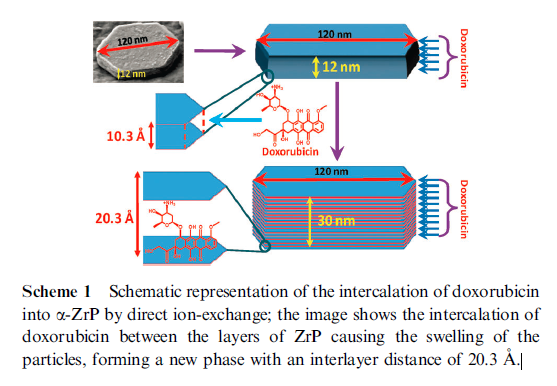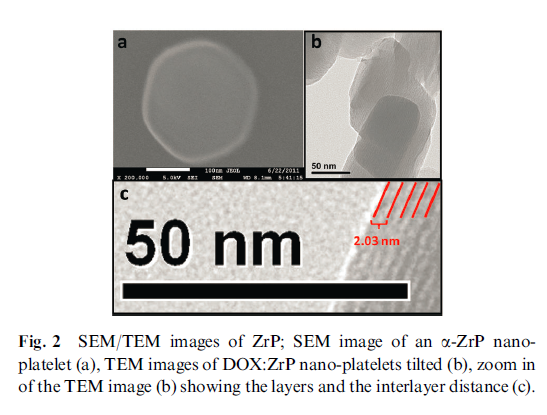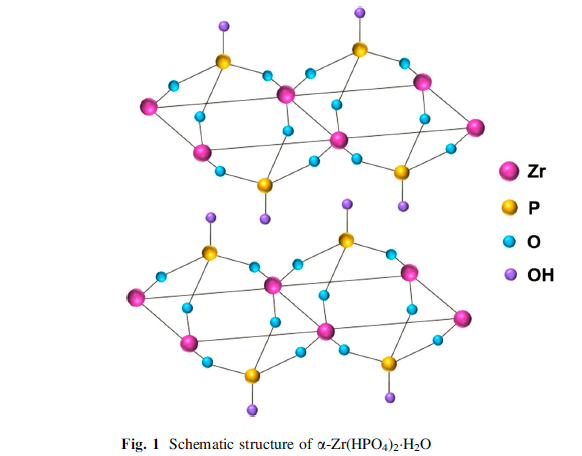Sunshine Factory, Co., Ltd. > Applications > ZrP for Drug DeliveryZrP for Drug Delivery
Zirconium phosphate nano-platelets: a novel platform for drug delivery In cancer therapy
Innovation New solutions
Doxorubicin was intercalated into novel zirconium phosphate nano-platelets (ZrP). The obtained doxorubicin intercalated ZrP nano-platelets had an impressive 34.9% (w/w) drug loading.
We used this material to deliver doxorubicin to breast cancer cells (MCF-7). Cellular studies with MCF-7 cells showed higher uptake and cytotoxicity of doxorubicin loaded ZrP compared to free doxorubicin.
Result
The superiority of ZrP materials over other ILN has been previously established:
(1) not cytotoxic and not associated with anymetabolic function;
(2) resolved crystal structures;
(3) almost no impurities (o0.01%);
(4) high ion exchange capacity of 6.64 meq. g-19 to accommodate higher loading of drugs;
(5) stability under biological conditions; (6) chemically modifiable surfaces; and (7) peculiar nano-platelet shape.
The particle shape of ZrP is platelet-like, which compared to spherical shape particles should show better adhesion, margination, and binding properties. In summary the particle size, shape, and ion-exchange intercalation chemistry make them very attractive for drug delivery of anticancer agents.
ZrP nano-platelets loaded with the drug may reach the tumor by an enhanced permeability and retention (EPR) effect of cancerous tissues, enter into the cell via endocytosis and release the drug (via ion-exchange) under the acidic conditions of the endosomes and lysosomes.




Introduction
ZrP are acidic, inorganic cation exchange materials that have a layered structure.
The structure of the alpha phase of ZrP (a-ZrP) consists of layers with the zirconium atoms slightly above and below the plane of the layer bonded to phosphate groups above and below the plane (Fig. 1).
 Three oxygen atoms of each phosphate group bond three different zirconium atoms making a covalent network. The fourth oxygen atom of the phosphate groups bears an exchangeable proton pointing toward the interlayer region, allowing the intercalation of cations by ion exchange or by acid–base interactions.
Three oxygen atoms of each phosphate group bond three different zirconium atoms making a covalent network. The fourth oxygen atom of the phosphate groups bears an exchangeable proton pointing toward the interlayer region, allowing the intercalation of cations by ion exchange or by acid–base interactions.
In addition, a-ZrP has the capacity to incorporate cations with radii smaller than 2.61 Å into their layers, via direct ion exchange, without the use of preintercalators.
However, a hydrated phase of a-ZrP, has the ability to sequester relatively large cations via direct ion exchange (such as metal complexes, insulin, and polycyclic aromatic hydrocarbons, among others) without the need of any pre-intercalator.
Additionally, the chemical structure and shape of the ZrP layer (hexagonal nano-platelets) remain unaltered upon intercalation.
Doxorubicin was intercalated into novel zirconium phosphate nano-platelets (ZrP). The obtained doxorubicin intercalated ZrP nano-platelets had an impressive 34.9% (w/w) drug loading.
We used this material to deliver doxorubicin to breast cancer cells (MCF-7). Cellular studies with MCF-7 cells showed higher uptake and cytotoxicity of doxorubicin loaded ZrP compared to free doxorubicin.
Result
The superiority of ZrP materials over other ILN has been previously established:
(1) not cytotoxic and not associated with anymetabolic function;
(2) resolved crystal structures;
(3) almost no impurities (o0.01%);
(4) high ion exchange capacity of 6.64 meq. g-19 to accommodate higher loading of drugs;
(5) stability under biological conditions; (6) chemically modifiable surfaces; and (7) peculiar nano-platelet shape.
The particle shape of ZrP is platelet-like, which compared to spherical shape particles should show better adhesion, margination, and binding properties. In summary the particle size, shape, and ion-exchange intercalation chemistry make them very attractive for drug delivery of anticancer agents.
ZrP nano-platelets loaded with the drug may reach the tumor by an enhanced permeability and retention (EPR) effect of cancerous tissues, enter into the cell via endocytosis and release the drug (via ion-exchange) under the acidic conditions of the endosomes and lysosomes.




Introduction
ZrP are acidic, inorganic cation exchange materials that have a layered structure.
The structure of the alpha phase of ZrP (a-ZrP) consists of layers with the zirconium atoms slightly above and below the plane of the layer bonded to phosphate groups above and below the plane (Fig. 1).

In addition, a-ZrP has the capacity to incorporate cations with radii smaller than 2.61 Å into their layers, via direct ion exchange, without the use of preintercalators.
However, a hydrated phase of a-ZrP, has the ability to sequester relatively large cations via direct ion exchange (such as metal complexes, insulin, and polycyclic aromatic hydrocarbons, among others) without the need of any pre-intercalator.
Additionally, the chemical structure and shape of the ZrP layer (hexagonal nano-platelets) remain unaltered upon intercalation.

Follow WeChat


